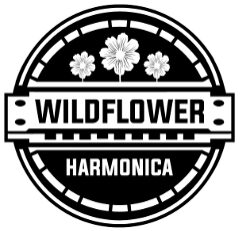Harmonica tablature tells you which hole to play, whether it’s a blow or draw note, and whether a bend or other effect is required. In the system I use with my students, plain numbers are blow notes and numbers with a minus sign are draws.
Blows & Draws
1 means blow on hole 1
-1 means draw on hole 1
Double Stops
1,2 means blow on holes 1 and 2 together
-1,2 means draw on holes 1 and 2 together
Bends
-3′ means draw on hole 3 with a half-step bend
-3″ means draw on hole 3 with a whole-step bend
-3″‘ means draw on hole 3 with a step-and-a-half bend
Same idea for blow bends, except the number won’t have a minus sign.
Chromatic Harmonica
For chromatic harmonica, parentheses tell you to push the slider button:
(-1) means draw on the first hole while pushing the button.
Overblows and Overdraws
On the diatonic harmonica, I use parentheses to indicate overblows and draws:
(4) means play an overblow on hole 4.
(-7) means play an overdraw on hole 7.
There are a number of harmonica tab systems out there, but I prefer this one because it uses only ASCII keyboard keys, which makes it easier to type up songs and transmit them online. Other systems use up and down arrows, or circles around the numbers to communicate blows and draws.
Rhythm & Your Ear
Simple tab systems don’t give you rhythm instructions, so they work best to get you started on songs you’re already familiar with. It is possible to learn new songs using tab, but you’ll need audio examples to demonstrate how they’re supposed to go. It’s also not a bad idea to get used to listening closely to songs, tapping your foot, and singing along with melodies to develop your ear.
Standard Notation
I’m all for learning to read traditional music notation, since it communicates rhythm and articulations better than tab, and in the long term it’s a great investment in your musicianship. In the short term though, it’s probably more important just to get started playing music immediately, so you can get thoroughly hooked on playing your harmonica. In my experience, numeric tab requires less translation by your brain and gets the basic idea across more quickly.
